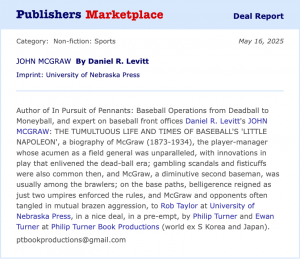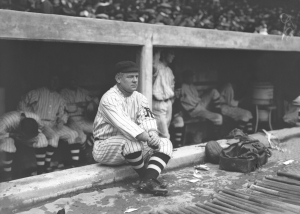As readers of this blog will know, I grew up in Cleveland, Ohio, and under the tutelage of my sports-loving dad, I became a fan, too. I remain a fan and a follower of all the Cleveland professional sports team, the NBA Cavaliers (By lottery this week they won the first pick in the upcoming collegiate draft, a pleasant prospect.); the NFL Browns (I attended the last Cleveland pro sports championship, when the Browns won the NFL title in 1964, two years before the minting of the Super Bowl.); and the baseball Indians (In case you wonder, I am tired of the nickname, embarrassed by it, and wish the franchise would dump it; I tend to just call them the Tribe or CLEVE. At least this year the front office, though still resisting calls to change names, they do seem to have sidelined the brazenly racial “Chief Wahoo” mascot logo.). The history of failure–or least, shortfalls of the ultimate goal–by my teams, hasn’t deterred my fanship, illustrated by a piece I wrote last year, How to Enjoy Sports Even When Your Teams Have a History of Failure.
The Tribe haven’t won a World Series since ’48. This season, so far, the team has been playing surprisingly well, and at the moment they lead their division by a half-game. In their past 25 games they must be playing at about a 17-win and an 8-loss clip. They could still collapse after July 4th, but things look bright right now.
The above is prelude to the fact that last night the Tribe opened a 4-game series in Boston vs. the Red Sox at Fenway Park. It was the first game back in Boston for Terry Francona, now the CLEVE manager, after he held the job in Boston for 8 years, until 2011. As this Cleveland Plain Dealer story reminds, he won two World Series championships during that tenure, and then was quite unceremoniously dumped by the BOSOX brain trust. I’m really glad Cleveland has him in the dugout now. I’m sure his calm leadership is one of the reasons the Tribe is playing so well this season. Who knows, maybe the team can keep it up.
Last night’s game ended up as a route, for my side. The Tribe scored early and often. Their march through the innings went like this: 1-0; 4-0; 4-3; 5-3; 6-3; 12-3, the final score. The Tribe currently leads the American League in homers, with 60, yet oddly last night, though hitting double digits in run production–though they had a total of 16 base hits, with 4 doubles and a triple–they did not hit a homer. Still, it’s alright, for as Mark Reynolds the Tribe’s leading basher with 12 HRs puts it in beat writer Paul Hoynes’ game story, “‘Sometimes, homers are rally killers,’ said [the DH/3rd baseman] with a laugh.”
 Very excited to have sold a great new baseball book to Rob Taylor at University of Nebraska Press, one of the very best editors and publishers of sports books. John McGraw: The Tumultuous Life and Times of Baseball’s ‘Little Napoleon’ by Daniel R. Levitt. It will be the first full biography of the New York Giants’ legendary player-manager in two decades, apart from a 2018 book that focused mostly on McGraw’s many ejections from games. As described in my announcement of the deal, his “acumen as a field general was unparalleled, with innovations in play that enlivened the dead-ball era….[But with] gambling and on-field fisticuffs common….McGraw, a diminutive second basemen was usually among the brawlers; on the base paths, belligerence reigned as just one or at most two umpires enforced the rules, and McGraw and opponents often tangled in mutual brazen aggression.” With a tip of the ball cap to publishing pal David Wilk, who referred the author to me. For publication in 2027. #baseball #biography #NewYorkCity #DeadBallEra
Very excited to have sold a great new baseball book to Rob Taylor at University of Nebraska Press, one of the very best editors and publishers of sports books. John McGraw: The Tumultuous Life and Times of Baseball’s ‘Little Napoleon’ by Daniel R. Levitt. It will be the first full biography of the New York Giants’ legendary player-manager in two decades, apart from a 2018 book that focused mostly on McGraw’s many ejections from games. As described in my announcement of the deal, his “acumen as a field general was unparalleled, with innovations in play that enlivened the dead-ball era….[But with] gambling and on-field fisticuffs common….McGraw, a diminutive second basemen was usually among the brawlers; on the base paths, belligerence reigned as just one or at most two umpires enforced the rules, and McGraw and opponents often tangled in mutual brazen aggression.” With a tip of the ball cap to publishing pal David Wilk, who referred the author to me. For publication in 2027. #baseball #biography #NewYorkCity #DeadBallEra







